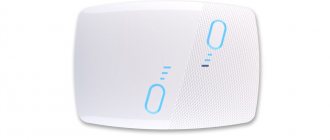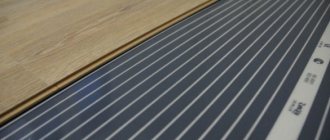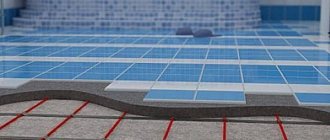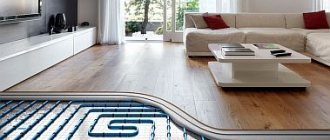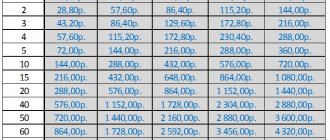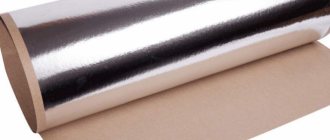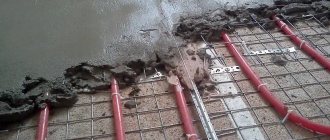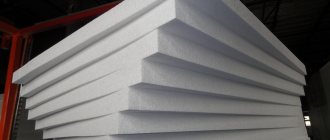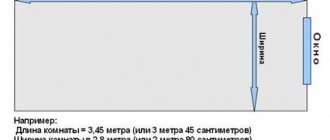OSB boards are a very durable and load-resistant material based on wood fibers. In the manufacture of slabs, wood species such as aspen and pine are used. The material is pressed in three layers, the fibers in each layer are multidirectional, which explains the density of the OSB board.
Important: The size of the chips, which are the basis of OSB boards, allows the material to withstand significant mechanical loads. At the same time, the plate does not deform and remains flexible.
Infrared heated floor - from theory to practice
Today you won’t surprise anyone with alternative heating systems; the heating system has long ceased to be perceived as a wall-mounted line with radiators. Warm floors are one of the most popular heating methods, used as an additional or independent circuit. There are two types of underfloor heating systems - with a liquid coolant, most often water, and electric - with heating elements. Although infrared heated floors belong to the second type, they can hardly be called electric. Although these systems have been in use for almost a decade, less is known about them than their traditional counterparts, despite many positive characteristics. Naturally, this system did not pass by our forum members; many FORUMHOUSE participants heat their homes using infrared heated floors.
Advantages and disadvantages
Warm floors are quite popular today and are used by many owners of private houses. Heat transfer in these systems is carried out due to pipes located under the floor covering, through which heated coolant circulates, or through electric heating elements.
As a result, the floor heats up and becomes warm to the touch, which in itself significantly increases the level of comfort in the home.
Among the positive qualities of a heated floor, the following stand out most clearly:
There are also disadvantages:
The advantages of heated floors are significant, and the disadvantages are not critical, so such heating systems can be used for heating, both as the main and as an additional source of heat.
Historical reference
For the first time, invisible radiation located beyond the red part of the spectrum was discovered by the British astronomer with German roots, William Herschel, in 1800. A little over a century later, our compatriot, physicist A. A. Glagolyeva-Arkadyeva, experimentally obtained a radio wave, the length of which corresponded to the range of infrared radiation. This proved that infrared radiation is a type of electromagnetic waves, it is as natural as the light and radio waves that surround us. Infrared radiation (IR) is electromagnetic radiation with shorter wavelengths than visible light (from 0.8 microns to 1-2 mm). Infrared waves are emitted by any heated bodies; in theory, they are understood as bodies with a temperature higher than absolute zero (-273.15⁰С), therefore IR radiation is thermal. However, some substances do not transmit this type of rays, for example, water. Infrared radiation is divided into several regions according to wavelength, and the wavelength depends on the temperature of the emitter (heated object):
As for the relationship between theory and practice, it is direct - the heating elements of an infrared heated floor do not heat up to 100⁰ and produce safe long waves. Therefore, the categorical statements of opponents of this system about its harmfulness are groundless. But marketing praises about the undoubted benefits are also far from the truth - the useful range will dampen most floor coverings. Infrared heated floor is an alternative heating system with its own advantages and disadvantages, and not a way to turn a house into a physiotherapy room.
System components
The basis of all IR underfloor heating systems is the ability of certain carbon-containing substances to release heat in the infrared range when current passes through them. What is typical is that radiation heats not only the air, as in the case of other systems, but also objects, which, in turn, also give off heat. By the way, the positioned “newest” technology was successfully used by the domestic automobile industry at the end of the last century, as noted by portal user Aleks074.
Well, they created some uniqueness here; back in the six-wheel basins of the eighties, this technology was used to heat the rear windows.
Today, there are three ways to organize underfloor heating using infrared radiation, depending on the emitters used.
Film flooring is intended for installation under floor coverings without “wet” processes - laminate, linoleum, carpet and the like. On the one hand, this is a plus - there are a minimum of problems with installation, on the other hand, you cannot put it under tiles, which are especially popular in technical rooms.
Rod mats are designed for laying in a screed, and if the base is flat, you can immediately install the tiles on the glue, without an additional layer, but the total thickness of the coated glue should not be less than 2 cm. Our forum members use both films and cables.
Film TP is good because it can be laid on parquet boards. This is how I did it, no matter how you look at it, no coating is completely “transparent”. And everything that passes through heats objects: a table, stairs, walls, that’s the whole point. You open the windows wide, ventilate, and when you close everything, it’s warm again. Because not only the air is warm, but everything around it.
I bought five hundred meters of such cable, three thermostats. Fifty meters of tile adhesive under the porcelain tiles, one hundred and thirty-two meters laid under the laminate, checked, everything is warm. At a height of one and a half meters from the laminate, thermal radiation from the floor is felt. The cable was cut into sections of eleven meters, this way it warms up better, but the electricity consumption also increases.
IR heated floors operate from a power supply voltage of 220 - 230 Volts (50 Hz), the system includes not only an emitter in the form of film, mats or cable, but also a temperature sensor and thermostat. These devices provide optimal heating of the room with minimal energy consumption. The system will maintain the set parameters, increasing or decreasing heating as needed. Depending on the type of infrared floor and the energy-saving characteristics of the room, a system with a power of 150 W/m² to 200 W/m² is installed. If the floor is used as auxiliary heating, a minimum power is sufficient; if it is used as the main heating, you will have to use the maximum.
The heated floor should occupy 60–80% of the floor surface in the room, but the exact numbers will depend on the power of the specific brand and the characteristics of the room. Typically, selling companies themselves calculate the coverage area based on the data provided by the buyer.
Thermostats
Manufacturers offer many different types:
- Mechanical (analog) regulators are the simplest and most reliable.
Appearance of a mechanical thermostat
- Digital - with liquid crystal displays, which display several parameters: the temperature of the floor covering, the air in the room, and sometimes the current time.
Appearance of a digital thermostat
- Digital programmable thermostats - allow you to set a certain temperature at different times of the day (day - night) or by day of the week. In the absence of people, the temperature drops and rises before arrival, this makes the operating mode more economical.
Programmable thermostat
- Thermostats with remote control can be controlled by a remote control in the infrared range, as on TVs, via a radio channel. More expensive models work over the GSM network, over the Internet online, and are controlled from an iPhone, tablet or PC, from any place where there is a cellular connection or cable Internet.
Thermostats differ in their controls: in mechanical models, the wire resistance is changed by a moving contact on a plastic disk in the device body.
In digital regulators, the resistance is changed by a microcircuit, which includes an electronic switching relay. Control can be carried out by mechanical buttons or touch segments on the display, as on mobile iPhones or tablets.
Regardless of the thermostat model, the control units are connected according to a typical scheme to elements with the same functional purpose:
- to 220V network;
- to the heating cable;
- to one or more temperature sensors;
- through grounding.
For safety reasons, all electrical heating systems in private households are connected to the network in the distribution panel through a short circuit protection circuit breaker and an RCD (touch protection device).
Installation
Regardless of the type of infrared floor, it needs a properly prepared base, the surface must be strong and smooth, a difference of no more than 3 mm per m² is allowed. A heat-insulating substrate is laid on top of the clean subfloor with the foil part facing out, the overlaps are sealed with tape (aluminum), it will prevent radiation from penetrating downwards. The film, mats, and cable are laid at a certain distance; overlaps of emitters are unacceptable. The method of fastening the elements of the system depends on its type; double-sided or special tape, plastic ties or improvised devices are used.
Forum member Kotoffey fixed the IR cable this way.
I do it primitively: foil insulation, a steel mesh with a cell of 9 x 7 cm is the thinnest, since its role is only to hold the cable, I fixed the cable with ties, respectively, where I want it warmer - a step of 7 cm, where I don’t want it - 9 cm, contacts brought him out of the floor.
Sergeypotseluev laid the cable under the laminate, without a tie, so he installed it according to a different scheme.
The first layer was covered with a foil backing with the aluminum coating facing up, then I drew the boundaries of the built-in furniture on the backing. I sealed the joints of the substrate with aluminum tape (precisely aluminum), glued strips of thin double-sided tape in increments of 50 cm at the places where the cable was laid. Then I laid the cable on this tape in increments of 8 cm, gradually covering the entire heating zone in pieces of 11 meters. The ends of the cable were placed in one direction for ease of connection to live wires. I laid laminate on top. In general, I repeated the seller's recommendations.
To connect the mounting wires to the current conductors, crimp sleeves or special connectors are used; they are usually supplied with detailed installation and installation instructions. All connections are carefully insulated to avoid short circuits and system failure. The joints may turn out to be thicker than the main fabric. If we are talking about a system laid under a laminate, it is recommended to cut grooves in the base in advance in order to “sink” the protruding parts into the floor and prevent squeezing. When a screed is used, high-quality insulation is sufficient; as an option, a corrugated pipe is used, into which a temperature sensor or temperature sensors are also placed when the coverage area is large. Sergeypotseluev installed such an IR cable system.
If a film covering is installed, a polyethylene film is laid on top of it, some use moisture and wind protection, and a backing is used under the laminate. When covering soft materials, such as carpet or linoleum, plywood, OSB or a similar base is first laid.
Kotoffey is quite pleased with the performance of his heated floor.
Yesterday I left a bathhouse with working floors set at 40⁰ overnight and arrived in Tashkent in the morning. My 1.6 kW in total across the floor perfectly heats my frame sauna, then I turned off the system, but the window was open all day and it was still a little hot inside, inertia. In winter I plan to test it as the only source of heating, in constant mode.
Be that as it may, any system has its advantages and disadvantages, which are revealed during use; the best theory can fail. IR heated floors are an alternative heating method that has found its consumer, including among portal users.
Source
The main advantages of OSB boards
Modern equipment and the latest technologies used in production make it possible to produce OSB boards of high quality and strength. The composition of the material is homogeneous throughout the entire volume. The slabs have no chips or cracks. There are no voids or cavities inside the OSB.
Thanks to its excellent performance characteristics, OSB is an excellent option for rough floor finishing. Almost any finishing coating can be laid on top of the material.
OSB boards are easy to install
The use of OSB boards allows you to obtain the following advantages:
Due to their excellent performance characteristics, OSB boards are the preferred option for rough finishing of floors. The demand for coating is constantly growing.
Classification of OSB boards
The strength of OSB boards exceeds the similar characteristics of chipboard sheets. This is primarily due to the size of the wood fibers. The chips in OSB are larger than in chipboard, both in length and width. Modern equipment allows you to lay chips in different directions. As a result, the OSB board is stronger and more resistant to fractures.
Note: If you compare OSB and chipboard, then boards made from the first material are more durable and reliable. It is preferable to use them as a rough floor covering.
OSB boards are divided into several types
Today you can purchase OSB boards, divided into four classes according to their main performance characteristics. The material is classified according to strength and moisture resistance. Depending on the type of slabs, they can be used for various purposes, from arranging flooring to interior partitions and roofing bases.
Indicators of resistance to moisture differ for each class. An OSB-1 board can swell by a quarter of its volume, and an OSB-2 class by a fifth. Such materials are best used in places where the humidity level is not high.
Boards of classes OSB-3 and OSB-4 are much less susceptible to moisture. The first material can swell by no more than 15 percent, and the second by 12 percent. Moreover, the cost of OSB-4 far exceeds the similar characteristics of materials of other classes. Therefore, OSB-3 is the most popular for rough finishing, which is confirmed by sales volume.
Types of OSB boards
Another important parameter by which OSB boards are classified is strength. The elasticity of the material during fracture along the transverse and longitudinal axes is assessed. In both the first and second cases, the OSB-1 board has the lowest strength, equal to 1200 and 2500 newtons per square millimeter, respectively. Similar figures for OSB-4 are much higher and amount to 1800 and 4800 newtons per square millimeter, respectively. For OSB-2 and OSB-3 boards, the first longitudinal elasticity is 1.4 and 1.5 N/mm², and the transverse elasticity is 3.5 and 3.6 N/mm².
In terms of strength characteristics, OSB-2 and OSB-3 boards are almost identical, so the choice of coating is made based on the requirements of moisture resistance. OSB-4 board has higher performance characteristics, but due to its high cost it is used in special cases.
Types of heat insulators
All heat insulators have their own characteristics. There are several types of thermal insulation materials.
Do-it-yourself floor insulation
If you are going to make a concrete floor or cement screed, then it is better to insulate the floor with expanded clay and mineral wool. You can also use foam with a fine-grained structure.
Gypsum fiber has become very popular lately. This is a material made from gypsum with the addition of wood fibers. Gypsum fiber is environmentally friendly, very durable and resistant to moisture. To make it easier to insulate the floor, gypsum fiber sheets are available for sale. They stick together like laminate. But you can also buy prefabricated combined floors - two gypsum fiber boards are connected to a heat-insulating layer of expanded polystyrene.
You can also insulate floors yourself using water heating. To do this, you will need a solid pipe made of metal-plastic or copper, which is mounted under the floor of the room in the form of a snake. After which it is filled with screed, instead of which you can use a special mixture for heated floors.
Insulating the floor yourself is not an easy task. If you doubt your abilities, it is better to call professionals for help.
Floor in a frame house - what to make it from
Of course, a cold floor in your home will not make it feel cozy. Therefore, sufficient attention should be paid to insulating the floor in your home.
Most often, the floor in a frame house is made of wooden beams. For such houses, this is one of the best options, ensuring environmental friendliness and savings. As a rule, deciduous and coniferous wood species are chosen for beams. Please immediately note that the floor must meet the following requirements:
How to properly make floors in a frame house
What materials will be needed to install the floor: Logs with a diameter of 14 cm. A timber with a section of 100 by 80 cm is also suitable. These are the so-called logs (logs for supporting floors).
A tongue and groove board with a thickness of 40 mm or more. It will act as a flooring for your floor.
You will need red brick for construction work. It will support the joists.
You will also need: cement, gravel, sand.
Gravel is needed to construct supports for the logs, as well as an area for supports. But fine gravel and lime are used for work with the underlying layer.
Ruberoid and mesh netting and material for fastening elements.
Roofing material will be needed to insulate the layer between the supports and joists
The chain-link mesh will act as a reinforcing material for the platform for the supports, and various nails will help fasten the boards to the joists. We choose logs in the range from 80 to 100 mm, and the size of the nails is already affected by the thickness of the floor board. Approach the arrangement of lags more carefully so that there are no problems during the finishing work.
The first thing to do is create an earthen “pillow”. This stage still affects the foundation work, so let us remind you that you need to remove the top layer of soil, about 30 cm (about 30 cm), then cover everything with a layer of dry soil, and compact it. On top of the soil, add a small layer of crushed stone. It is better to take gravel in small fractions; compact it ideally into the soil. Then we lay a layer of lime and crushed stone. The correct proportion is one to four, and then pour a layer over the entire area, but not less than 15 cm.
Insulation of concrete floor
Materials for insulating concrete floors - polystyrene, OSB, anchors, glue, primer, polyurethane foam
Concrete floors have enormous physical strength and are not afraid of moisture, fire, or various chemicals.
How to make concrete warm?
As a rule, a concrete floor in a private house is laid on a soil base, but this can only be done when the soil is dry. Otherwise, problems with waterproofing may arise. Typically a concrete floor includes the following layers:
This material is universal
OSB material appeared on the market quite recently and has become an alternative to chipboard or plywood coatings. OSB is used for the construction of frame buildings and as insulation in individual construction. OSB boards are most widely used as leveling, heat and sound insulating floor coverings. The slabs can be laid on concrete and wooden floors, on joists, as well as on any surface prepared for finishing.
OSB boards are a universal material; they can be used for both interior and exterior decoration.
OSB boards of different classes are suitable for the following applications:
Tip: For rough finishing of floors, OSB-3 should be used. The material is universal and affordable. It can be used in fairly humid conditions.
The thickness of the coating is selected based on the characteristics of the existing floor. If there are minor irregularities, then the surface can be leveled using slabs no more than 10 millimeters thick. The surface with holes and potholes of sufficient depth is leveled with material up to 15 millimeters thick. If OSB is laid on logs, its thickness varies from 15 to 25 millimeters.
OSB for heated floor
In house construction, especially wood, several types of flooring are used to install heated floors: slatted and modular. With the modular method, a heated floor under chipboard is formed into modules. The chipboard panel contains channels for the pipeline contour. With the rack method, pipes are placed on the surface of chipboard of the required width, and iron strips are placed in the grooves, where a conventional heating circuit is then placed. A specialized gasket is laid on the pipeline to absorb condensate and the final floor covering is laid.
Guides for heated floor pipes under chipboard
Oriented strand boards are quite necessary; they are used to level curved surfaces. Laying slabs on a wooden surface makes the floor covering stronger and warmer. Any type of floor covering can be installed on a similar base. Oriented strand boards are also used for electric floors.
Boards Oriented Strand Boards
The advantages of the material include the following characteristics:
wood floor
Hydraulic heated floors on OSB boards are placed where it is not possible to create a screed: with low ceilings, on wood bases. Excellent properties of this method:
The water heated floor system involves the process of installation on a wooden base with OSB grooves using heat distribution plates. A moisture-proofing substrate is laid on the pipes, the final floor covering
made of laminate, wooden parquet.
Floor heated water floor
The heated floor system is made from special OSB modules and planks. The modular installation method involves the use of Oriented Strand Boards - ready-made modules for the circuit. The rack system is made of slats or boards.
The general process for laying floors on wooden joists is as follows:
Attention! If tiles or linoleum are laid on a heated floor, then chipboard, OSB, plywood, wood boards, and gypsum fiber boards are laid on top of the plates. They are fastened, the joints are puttied. In this case, the final covering is laid in the usual way.
Warm electric flooring
Floor heating is done in compliance with the rules for the safety of its operation and long-term use. There are different types of electrical
heated floor: mats for heated floors, heating cable, infrared film. At the beginning of installation, you need to prepare the base:
Next, place the selected heater. If it is a wire, then it is verified (the resistance is measured), guides are attached according to the layout diagram, spread on OSB without twisting or bending, sensors are installed, power is connected, a screed is made 3 cm wide. Heating mats are laid in the same order.
If heated film floors are installed, the technical specifications of which allow them to be placed under different floor coverings , then the following work is carried out: the thermal film is spread on a rigid OSB base, not reaching the heating pipes 30 cm. Connection and installation of sensors is carried out according to the diagram in the technical documentation.
After installing the heater into the heating system, you can lay an OSB board on top, and the finishing floor covering on it.
It is completely possible to put a heated floor under chipboard, you just need to choose the best option, follow the instructions, technology and home comfort are guaranteed for a long time.
The process of installing a heated floor without using a cement-based screed:
OSB (oriented strand board) is a material successfully used in construction and furniture manufacturing. From the outside it resembles chipboard, but there is a significant difference in the new material. In the production of OSB, large shavings and chips are used, laid in layers.
If odd layers are laid along the length of the slab, then even layers are placed across. A small number of layers - three. This crossing of chips and chips provides the material with the highest fracture strength. Those who are now concerned about building a house or renovating it are wondering: is it possible to lay an OSB board on the floor?
According to aspects of water resistance, OSB is divided into 4 classes in Europe:
For flooring, manufacturers produce slabs with a tongue-and-groove edge, which ensure the most snug fit of the slabs to each other. And when asked whether it is possible to lay OSB on the floor, the manufacturer gives an affirmative answer, offering consumers materials of varying thickness and moisture resistance.
On video : properties and individualities of material implementation
Before choosing a flooring material, you need to decide what technology you want to use to lay the floor. OSB flooring can be rough or finished. The subfloor is laid under linoleum, laminate, parquet, or carpet. The front floor is covered with several layers of varnish or paint in order to improve the decorative coating and the highest resistance to moisture. OSB is laid on a cement-concrete screed, on an old wood floor, or laid on logs.
Regarding the question - is it possible to lay OSB specifically on a screed? There are a variety of ideas. Professionals, emphasizing personal experience, defend their points of view, and they are often contradictory among different professionals.
OSB is a relatively new material, and it is difficult to predict how it will behave in 10-15 years. Therefore, future homeowners who choose OSB as a floor covering also ask countless questions about this material.
It is possible to lay OSB on a cement screed, but for this the cement base must be completely level. To prevent the floor from moving, the cement screed must be coated with a special adhesive. The air humidity in the region where the house is being built does not have to be the highest. And if you live near a body of water and the air humidity is exceeded, then it is better to play it safe and put the slab on the logs.
In general, a warm floor is not bad under clay tiles, under laminate or linoleum laid on a cement screed. Wood under a heated floor system is not suitable.
Most craftsmen believe that it is more advisable to lay OSB on logs - beams 3-5 cm wide. This is necessary so that there is air circulation between the screed and the slab and moisture does not accumulate.
The beams must be impregnated with fire retardant and anti-bug agent. It is better that the moisture content of the timber does not exceed 20%; all beams should be similar in height (or thickness). If the floor is laid on the first floor, then it is recommended to lay bulk insulation or mineral wool between the joists.
The logs are placed at intervals not exceeding 50 cm from each other. The height of the beams is leveled with a level and a level. In places where the slabs are joined to each other, additional cross beams are placed, so that self-tapping screws are screwed into the logs to hold the slabs on them.
Almost all houses built in Russian times have wood floors. Cracks appeared somewhere and the boards were slightly warped. Due to countless stains, old floors look unpresentable, although they are still completely durable. Such a floor can serve as a base or subfloor for OSB.
Before laying OSB on an old floor, you need to carefully inspect the boards. Over decades of use of the wood floor, the nails have become loose, and even if you hammer them in, they will come out again. It is better to remove such nails and screw self-tapping screws into old boards, recessing the heads. In some places, you may have to use a plane to remove the bulges. The baseboards will also have to be removed.
Thus, OSB can be used as a flooring material. But in order for the floor to last for several decades, it is fundamentally important to choose it correctly. So that they don’t sell you Chinese properties instead of euros, ask the sellers for documents confirming the manufacturer, quality certificates, make sure that you are getting what you are paying for.
Why choose OSB-3
Increased moisture resistance is mainly achieved by using phenol-formaldehyde as a binder and adhesive material. But these materials are not recommended for indoor use. Moreover, in European countries the production of materials using formaldehyde is prohibited. Manufacturers have developed binders for gluing and pressing chips based on polyurethane resins. OSB-3 Bolderaja ECO is produced in Europe, which uses these safe resins. The material complies with the European product standard EN 300. True, such material is more expensive than usual, but is it necessary to save on health?
For flooring, manufacturers produce slabs with a tongue-and-groove edge, which ensure a tighter fit of the slabs to each other. And to the question whether it is possible to lay OSB on the floor, the manufacturer gives an affirmative answer, offering consumers materials of varying thickness and moisture resistance.
On video : characteristics and features of the use of the material
Laying OSB boards on a concrete surface
Very often the concrete screed does not have a smooth surface. In addition, the heat and sound insulation characteristics of such a coating leave much to be desired. Therefore, leveling a concrete base using OSB boards is a fairly popular procedure.
Laying the material on such a base is carried out in several stages:
Tip: If the floor in the room is flat, just drive dowels into the corners of each slab.
Laying OSB boards on a concrete surface
Using the technology of insulating a concrete floor with OSB slabs can significantly improve the performance parameters of the coating, as well as give the surface a perfectly flat shape and provide sound and heat insulation.
Laying OSB on a wooden floor
Old wood flooring often requires repair. Removing boards and laying new ones is not always justified, due to the high labor intensity and high cost. Therefore, the use of OSB is often justified and cost-effective. Using slabs, it is possible to level the surface and prepare it for final finishing.
Initially, the surface is localized, and existing irregularities are noted. In addition, if there are creaking and wobbly elements, they are attracted to the joists using screws. Replacing lags is used very rarely. After this, the surface of the boards is treated with a special tool that removes paint, varnish and levels the surface.
Laying OSB boards on a wooden base
OSB boards are laid offset, with a gap of three millimeters provided between them. There should be about 12 millimeters of free space from the wall to the outer slab. Each slab is attached to the floor along the entire perimeter with self-tapping screws over 45 millimeters long. In some cases, a second layer of OSB is installed, which makes the coating more durable. Combining seams of two layers is not allowed. After the polyurethane foam has dried in the grooves, you can begin finishing.
Leveling the ground plane of the floor using OSB plywood
Is it possible to lay tiles on Osby? It is possible, but certain conditions must be met. One of the most reliable methods of leveling the floor for laying ceramic tiles on a wooden base is OSB plywood. It is a slab of oriented and pressed glued chips. This material has sufficient strength and can withstand heavy bending loads. Sheets with a thickness of 12 and 20 mm are widely used. The advantages of the plate include primarily:
- High fire resistance. The stove is impregnated with a special composition that does not burn well, and in the absence of a catalyst is not flammable at all.
- OSB board repels water well. Due to the strong and hard impregnation, moisture cannot be absorbed into the material, thereby preserving what is underneath. Ceramic tiles on OSB will lie firmly and will not deform, which is usually observed on shock-absorbing surfaces.
So. Let's return to the technology of how to lay tiles on a wooden floor in the bathroom. OSB slabs can be laid directly on the floors, but the distance between them should not exceed 50 cm. The slabs can be laid not only on joists and floors. In case of careful treatment and complete prevention of sub-plank floors, they can be laid directly on old boards.
OSB board installation technology
It is important to know that it is better to use floorboards that have already lain down, but are very strong, because they are less prone to drying out and deformation when temperature and humidity change.
At this stage, maximum leveling of the base is carried out by placing plastic substrates in the required places. To level the floor for fastening OSB boards, shingles can be made in places where it is necessary to raise the level. Plus, some distance between the rough boards and the slabs will be a passage for ventilation of both the boards themselves and the OSB sheets. In addition, to improve ventilation, it is recommended to drill holes in the boards at even intervals. This condition allows us to confidently answer the question of whether it is possible to lay tiles on an OSB slab.
Laying OSB boards on logs
Another way to install the material is to lay it on wooden logs, under which there is a concrete base. Such a floor can be additionally insulated using special materials laid between concrete and OSB.
The logs are fixed to the concrete base with dowels or anchor bolts. The interval between lags depends on the thickness of the OSB. The thicker the slabs, the less frequently the base can be laid. With a material thickness of 15 to 18 millimeters, the interval between the logs should be 0.4 meters. If the slab thickness is over 22 millimeters, the base can be laid no more often than every 0.6 meters.
The height between the floor and the lower edge of the OSB boards is filled with steam and thermal insulation. The presence of a moisture-proofing layer is especially important if there is a fairly damp basement. As with other methods, it is not recommended to lay OSB sheets close to the walls and to each other.
Laying slabs on joists
Fixing the material to the joists is done with nails or self-tapping screws. Along the perimeter of the installation, the pitch is 15 millimeters, and it is recommended to screw self-tapping screws into the additional supports with a pitch of about 30 millimeters. The length of the screws should be 2.5 times the thickness of the material.
If there is no concrete base in the room, then the OSB flooring is laid in two layers. To do this, the first layer of OSB is laid on the logs. The lower surface of the material is treated with steam and waterproofing. Insulation, such as mineral wool, ecowool or polystyrene foam, is laid on top of the OSB. The second layer of OSB is applied to the insulation. After this, the floor is ready for finishing. When fixing the material, the above technologies are used.
OSB boards have gained great popularity in a fairly short period of time. With their help, you can prepare the floor for laying any finishing coating. Moreover, the technology is quite simple and does not require special knowledge and experience. In terms of its characteristics, the material is superior to its analogues, which explains the high demand for it.
Some rules for greater safety
The first time (about six to seven months) after installation, the most intense release of harmful fumes occurs. If you regularly ventilate the room, the negative impact on the body will soon begin to subside. But for greater safety, additional processing of the slabs is carried out.
If the work takes place in a children's room, then compositions with detoxifying properties are chosen as a primer. For common areas, simple water-dispersed paints, varnishes, wax, and penetrating primer are suitable.
Particular attention is paid to the ends. It is through them that the main amount of harmful substances is released
It is enough to saturate them with varnish or primer.
Priming is one of the safety measures that allows you to reduce the amount of harmful substances released
It should be taken into account that the rate of release of toxic elements is affected by temperature. The higher the indicator, the more formaldehyde in the air. The norm is considered to be 30 °C.
In general, there are two main ways that allow, without making excessive efforts, to rid the room of chemical components and saturate it with oxygen. Namely, frequent ventilation and the presence of indoor flowers.
OSB is not recommended for use in rooms where temperatures exceed 30 °C
Any modern building or finishing material that is made using chemical components can emit harmful substances. But manufacturers are constantly trying to keep these figures to a minimum.
